Hydraulic and Structural Assessment of a Rubble-Mound Breakwater with a Hybrid Wave Energy Converter
Abstract
:1. Introduction
2. Experimental Study of the Hybrid OWEC–OWC Device
2.1. Case Study and Test Plan
2.2. OWEC–OWC Concept and Physical Model
2.3. Facilities, Materials, and Equipment
3. Results
3.1. Structure’s Functionality
- For MLWS, the overtopping discharges are partially received by the HWEC’s reservoirs. This exhibits a greater effect than that associated with reflections or energy dissipations by the original breakwater armour layer;
- For MHWS, significant volumes of overtopping discharges are still received by the reservoirs. However, given the higher waterline level, the overtopping flow easily reaches the upper section of the HWEC. The reflections upon the crest’s vertical sections are responsible for the increment of .
3.2. Structure’s Stability
4. Conclusions
Author Contributions
Funding
Institutional Review Board Statement
Informed Consent Statement
Acknowledgments
Conflicts of Interest
References
- Hiranandani, V. Sustainable development in seaports: A multi-case study. WMU J. Marit. Aff. 2014, 13, 127–172. [Google Scholar] [CrossRef]
- Murphy, E.; King, E.A. An assessment of residential exposure to environmental noise at a shipping port. Environ. Int. 2014, 63, 207–215. [Google Scholar] [CrossRef] [Green Version]
- Pittaluga, I.; Borelli, D.; Repetto, S. Noise Pollution Management in Ports: A brief Review and the EU MESP Project Experience. In Proceedings of the 21st International Congress on Sound and Vibration, Beijing, China, 13–17 July 2014; p. 8. [Google Scholar]
- Winnes, H.; Styhre, L.; Fridell, E. Reducing GHG emissions from ships in port areas. Res. Transp. Bus. Manag. 2015, 17, 73–82. [Google Scholar] [CrossRef] [Green Version]
- Schipper, C.A.; Vreugdenhil, H.; de Jong, M.P.C. A sustainability assessment of ports and port-city plans: Comparing ambitions with achievements. Transp. Res. Part D Transp. Environ. 2017, 57, 84–111. [Google Scholar] [CrossRef]
- Becker, A.; Inoue, S.; Fischer, M.; Schwegler, B. Climate change impacts on international seaports: Knowledge, perceptions, and planning efforts among port administrators. Clim. Chang. 2012, 110, 5–29. [Google Scholar] [CrossRef]
- Becker, A.H.; Acciaro, M.; Asariotis, R.; Cabrera, E.; Cretegny, L.; Crist, P.; Esteban, M.; Mather, A.; Messner, S.; Naruse, S.; et al. A note on climate change adaptation for seaports: A challenge for global ports, a challenge for global society. Clim. Chang. 2013, 120, 683–695. [Google Scholar] [CrossRef] [Green Version]
- Acciaro, M.; Vanelslander, T.; Sys, C.; Ferrari, C.; Roumboutsos, A.; Giuliano, G.; Lam, J.S.L.; Kapros, S. Environmental sustainability in seaports: A framework for successful innovation. Marit. Policy Manag. 2014, 41, 480–500. [Google Scholar] [CrossRef]
- Lam, J.S.L.; Notteboom, T. The Greening of Ports: A Comparison of Port Management Tools Used by Leading Ports in Asia and Europe. Transp. Rev. 2014, 34, 169–189. [Google Scholar] [CrossRef]
- Puig, M.; Wooldridge, C.; Darbra, R.M. Identification and selection of Environmental Performance Indicators for sustainable port development. Mar. Pollut. Bull. 2014, 81, 124–130. [Google Scholar] [CrossRef]
- Vicinanza, D.; Contestabile, P.; Quvang Harck Nørgaard, J.; Lykke Andersen, T. Innovative rubble mound breakwaters for overtopping wave energy conversion. Coast. Eng. 2014, 88, 154–170. [Google Scholar] [CrossRef]
- Vicinanza, D.; Lauro, E.D.; Contestabile, P.; Gisonni, C.; Lara, J.L.; Losada, I.J. Review of Innovative Harbor Breakwaters for Wave-Energy Conversion. J. Waterw. Port Coast. Ocean Eng. 2019, 145, 03119001. [Google Scholar] [CrossRef]
- Di Lauro, E.; Lara, J.L.; Maza, M.; Losada, I.J.; Contestabile, P.; Vicinanza, D. Stability analysis of a non-conventional breakwater for wave energy conversion. Coast. Eng. 2019, 145, 36–52. [Google Scholar] [CrossRef]
- Bruun, P. Design and Construction of Mounds for Breakwaters and Coastal Protection; Elsevier: Amsterdam, The Netherlands, 2013. [Google Scholar]
- Naty, S.; Viviano, A.; Foti, E. Wave Energy Exploitation System Integrated in the Coastal Structure of a Mediterranean Port. Sustainability 2016, 8, 1342. [Google Scholar] [CrossRef] [Green Version]
- Arinaga, R.A.; Cheung, K.F. Atlas of global wave energy from 10 years of reanalysis and hindcast data. Renew. Energy 2012, 39, 49–64. [Google Scholar] [CrossRef]
- Gunn, K.; Stock-Williams, C. Quantifying the global wave power resource. Renew. Energy 2012, 44, 296–304. [Google Scholar] [CrossRef]
- Van der Meer, J.W. Geometrical design of coastal structures. In Seawalls Dikes Revetments; Pilarczyk, K.W., Ed.; Balkema: Rotterdam, The Netherlands, 1998; p. 15. [Google Scholar]
- Gerding, E. Toe structure stability of rubble mound breakwaters. In Delft and Delft Hydraulics Report H1874; Delft University of Technology: Delft, The Netherlands, 1993. [Google Scholar]
- CIRIA; Engineering CCFC; CETMEF. The Rock Manual: The Use of Rock in Hydraulic Engineering; Construction Industry Research & Information Association: London, UK, 2007. [Google Scholar]
- USACE. Coastal Engineering Manual Part VI: Design of Coastal Project Elements. In Place of Publication Not Identified; Books Express Publishing: Berkshire, UK, 2012. [Google Scholar]
- Van Gent, M.R.A. Rock stability of rubble mound breakwaters with a berm. Coast. Eng. 2013, 78, 35–45. [Google Scholar] [CrossRef]
- Van Gent, M.R.A.; van der Werf, I.M. Rock toe stability of rubble mound breakwaters. Coast. Eng. 2014, 83, 166–176. [Google Scholar] [CrossRef]
- Etemad-Shahidi, A.; Bali, M. Stability of rubble-mound breakwater using H50 wave height parameter. Coast. Eng. 2012, 59, 38–45. [Google Scholar] [CrossRef] [Green Version]
- Van der Meer, J.W. Stability of breakwater armour layers—design formulae. Coast. Eng. 1987, 11, 219–239. [Google Scholar] [CrossRef]
- Hudson, R.Y. Design of Quarry Stone Cover Layer for Rubble Mound Breakwaters; Waterways Experiment Station, Coastal Engineering Research Centre: Vicksburg, MS, USA, 1958. [Google Scholar]
- Vidal, C.; Medina, R.; Lomónaco, P. Wave height parameter for damage description of rubble-mound breakwaters. Coast. Eng. 2006, 53, 711–722. [Google Scholar] [CrossRef]
- Kralli, V.-E.; Theodossiou, N.; Karambas, T. Optimal Design of Overtopping Breakwater for Energy Conversion (OBREC) Systems Using the Harmony Search Algorithm. Front Energy Res. 2019, 7, 11. [Google Scholar] [CrossRef] [Green Version]
- Bingham, H.B.; Ducasse, D.; Nielsen, K.; Read, R. Hydrodynamic analysis of oscillating water column wave energy devices. J. Ocean. Eng. Mar. Energy 2015, 1, 405–419. [Google Scholar] [CrossRef] [Green Version]
- Bruce, T.; van der Meer, J.W.; Franco, L.; Pearson, J.M. Overtopping performance of different armour units for rubble mound breakwaters. Coast. Eng. 2009, 56, 166–179. [Google Scholar] [CrossRef]
- Van der Meer, J.W.; Verhaeghe, H.; Steendam, G.J. The new wave overtopping database for coastal structures. Coast. Eng. 2009, 56, 108–120. [Google Scholar] [CrossRef]
- De Rouck, J.; Verhaeghe, H.; Geeraerts, J. Crest level assessment of coastal structures—General overview. Coast. Eng. 2009, 56, 99–107. [Google Scholar] [CrossRef]
- Allsop, W.; Bruce, T.; Pearson, J.; Besley, P. Wave overtopping at vertical and steep seawalls. Proc. Inst. Civ. Eng.-Marit. Eng. 2005, 158, 103–114. [Google Scholar] [CrossRef] [Green Version]
- Romano, A.; Bellotti, G.; Briganti, R.; Franco, L. Uncertainties in the physical modelling of the wave overtopping over a rubble mound breakwater: The role of the seeding number and of the test duration. Coast. Eng. 2015, 103, 15–21. [Google Scholar] [CrossRef]
- Losada, I.J.; Lara, J.L.; Guanche, R.; Gonzalez-Ondina, J.M. Numerical analysis of wave overtopping of rubble mound breakwaters. Coast. Eng. 2008, 55, 47–62. [Google Scholar] [CrossRef]
- Cavallaro, L.; Dentale, F.; Donnarumma, G.; Foti, E.; Musumeci, R.E.; Carratelli, E.P. Rubble Mound Breakwater Overtopping: Estimation of the Reliability of a Numerical 3D Simulation. Coast. Eng. Proc. 2012, 1, 8. [Google Scholar] [CrossRef] [Green Version]
- Briganti, R.; Bellotti, G.; Franco, L.; De Rouck, J.; Geeraerts, J. Field measurements of wave overtopping at the rubble mound breakwater of Rome–Ostia yacht harbour. Coast. Eng. 2005, 52, 1155–1174. [Google Scholar] [CrossRef]
- Troch, P.; Geeraerts, J.; Van de Walle, B.; De Rouck, J.; van Damme, L.; Allsop, W.; Franco, L. Full-scale wave-overtopping measurements on the Zeebrugge rubble mound breakwater. Coast. Eng. 2004, 51, 609–628. [Google Scholar] [CrossRef]
- Van der Meer, J.W.; Allsop, N.W.H.; Bruce, T.; De Rouck, J.; Kortenhaus, A.; Pullen, T.; Schüttrumpf, H.; Troch, P.; Zanuttigh, B. EurOtop: Manual on wave overtopping of sea defences and related structures. EurOtop 2018. Available online: http://www.overtopping-manual.com/ (accessed on 1 August 2021).
- Sigurdarson, S.; van der Meer, J.W. Wave Overtopping at Berm Breakwaters in Line with EurOtop. Coast. Eng. Proc. 2012, 33, 12. [Google Scholar] [CrossRef]
- LNEC. Estudos em Modelo Físico e Numérico do Prolongamento do Quebra-mar Exterior e das Acessibilidades Marítimas do Porto de Leixões; Laboratório Nacional de Engenharia Civil (LNEC): Lisboa, Portugal, 2017. [Google Scholar]
- Calheiros-Cabral, T.; Clemente, D.; Rosa-Santos, P.; Taveira-Pinto, F.; Ramos, V.; Morais, T.; Cestaro, H. Evaluation of the annual electricity production of a hybrid breakwater-integrated wave energy converter. Energy 2020, 213, 17. [Google Scholar] [CrossRef]
- Cabral, T.; Clemente, D.; Rosa-Santos, P.; Taveira-Pinto, F.; Morais, T.; Belga, F.; Cestaro, H. Performance Assessment of a Hybrid Wave Energy Converter Integrated into a Harbor Breakwater. Energies 2020, 13, 236. [Google Scholar] [CrossRef] [Green Version]
- Pecher, A.; Kofoed, J.P. (Eds.) Handbook of Ocean Wave Energy; Springer International Publishing: Cham, Switzerland, 2017; Volume 7. [Google Scholar] [CrossRef] [Green Version]
- Iuppa, C.; Cavallaro, L.; Musumeci, R.E.; Vicinanza, D.; Foti, E. Empirical overtopping volume statistics at an OBREC. Coast. Eng. 2019, 152, 103524. [Google Scholar] [CrossRef]
- Margheritini, L.; Vicinanza, D.; Kofoed, J.P. Overtopping Performance of Sea Wave Slot Cone Generator. Coasts, Marine Structures and Breakwaters: Adapting to Change; Thomas Telford Ltd.: London, UK, 2010; pp. 750–761. [Google Scholar] [CrossRef] [Green Version]
- Contestabile, P.; Ferrante, V.; Di Lauro, E.; Vicinanza, D. Prototype Overtopping Breakwater for Wave Energy Conversion at Port of Naples. In Proceedings of the 26th International Ocean and Polar Engineering Conference, Rhodes, Greece, 26 June– 2 July 2016; International Society of Offshore and Polar Engineers: Rhodes, Greece; p. 6. [Google Scholar]
- Torre-Enciso, Y.; Ortubia, I.; de Aguileta, L.I.L.; Marqués, J. Mutriku Wave Power Plant: From the Thinking out to the Reality. In Proceedings of the 8th European Wave and Tidal Energy Conference, Uppsala, Sweden, 7–10 September 2009; p. 11. [Google Scholar]
- Arena, F.; Romolo, A.; Malara, G.; Fiamma, V.; Laface, V. The First Full Operative U-OWC Plants in the Port of Civitavecchia; Ocean Renew. Energy; ASME: Trondheim, Norway, 2017; p. V010T09A022. Volume 10. [Google Scholar] [CrossRef]
- Koutrouveli, T.I.; Di Lauro, E.; das Neves, L.; Calheiros-Cabral, T.; Rosa-Santos, P.; Taveira-Pinto, F. Proof of Concept of a Breakwater-Integrated Hybrid Wave Energy Converter Using a Composite Modelling Approach. J. Mar. Sci. Eng. 2021, 9, 226. [Google Scholar] [CrossRef]
- Cabral, T.; Clemente, D.; Rosa-Santos, P.; Taveira-Pinto, F.; Belga, F.; Morais, T. Preliminary Assessment of the Impact of a Hybrid Wave Energy Converter in the Stability and Functionality of a Rubble-Mound Breakwater. In Proceedings of the Coastal Structures Conference, Hannover, Germany, 29 September – 2 October 2019; pp. 1141–1151. [Google Scholar] [CrossRef]
- Rosa-Santos, P.; Taveira-Pinto, F.; Clemente, D.; Cabral, T.; Fiorentin, F.; Belga, F.; Morais, T. Experimental Study of a Hybrid Wave Energy Converter Integrated in a Harbor Breakwater. J. Mar. Sci. Eng. 2019, 7, 33. [Google Scholar] [CrossRef] [Green Version]
- Mansard, E.P.D.; Funke, E.R. The Measurement of Incident and Reflected Spectra Using a Least Squares Method. In Proceedings of the 17th International Conference on Coastal Engineering, Sydney, Australia, 23–28 March 1980. [Google Scholar] [CrossRef] [Green Version]
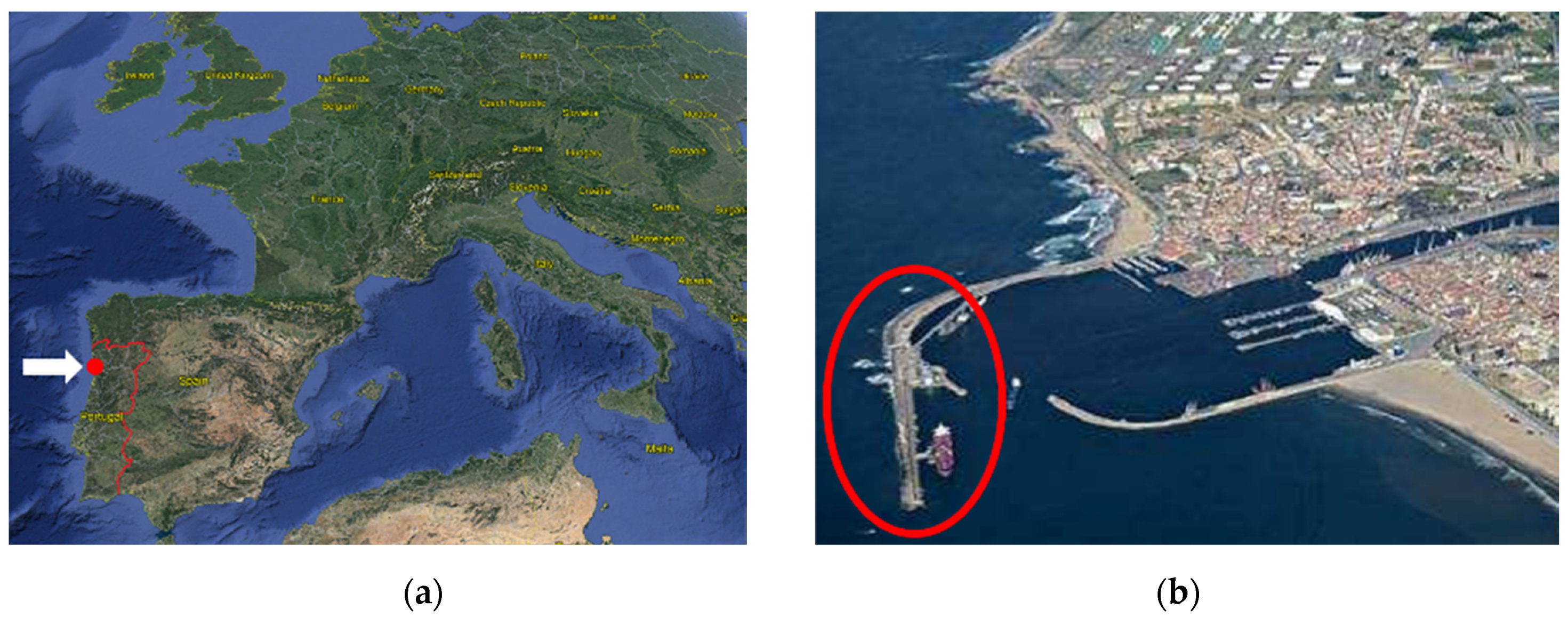
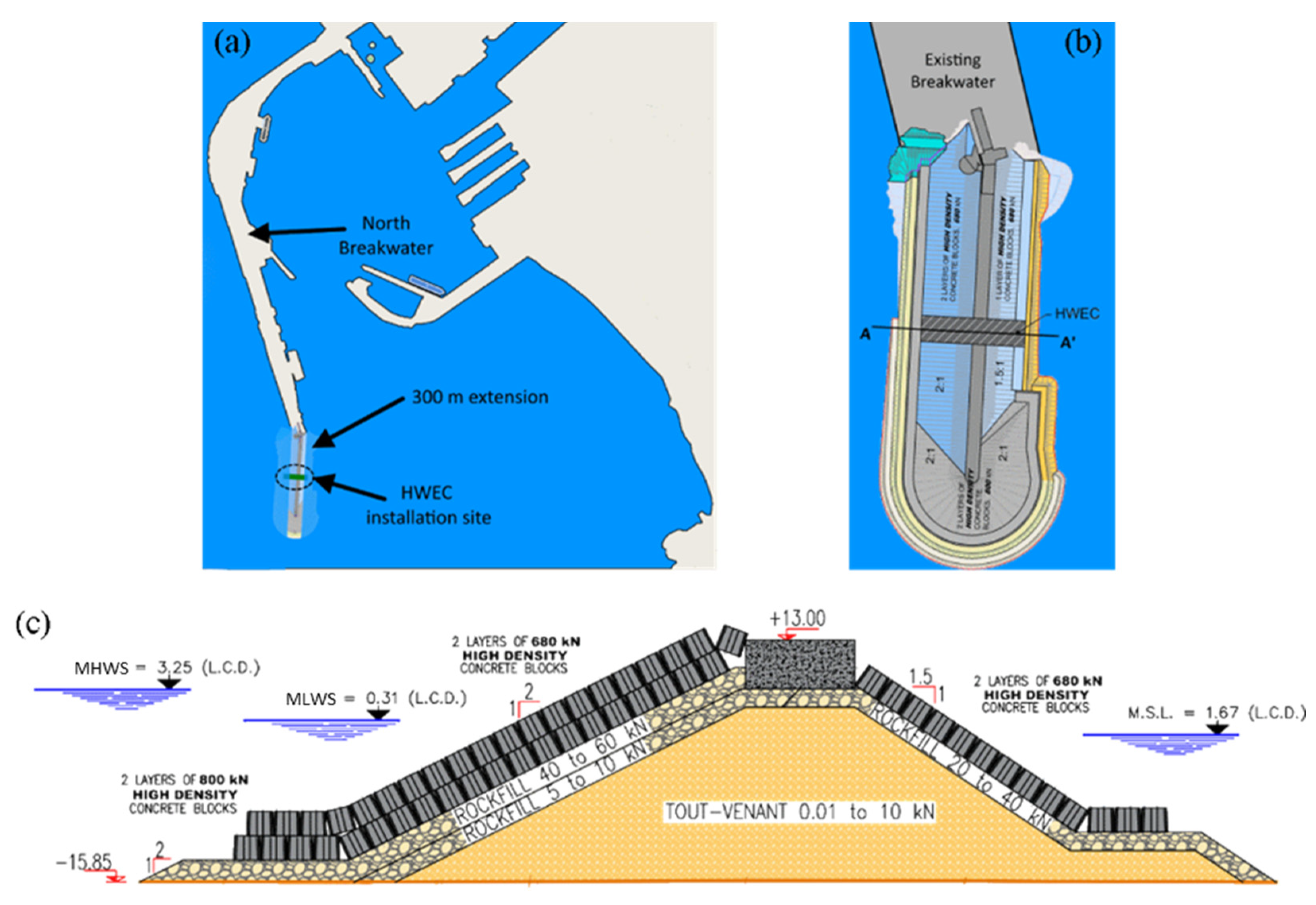
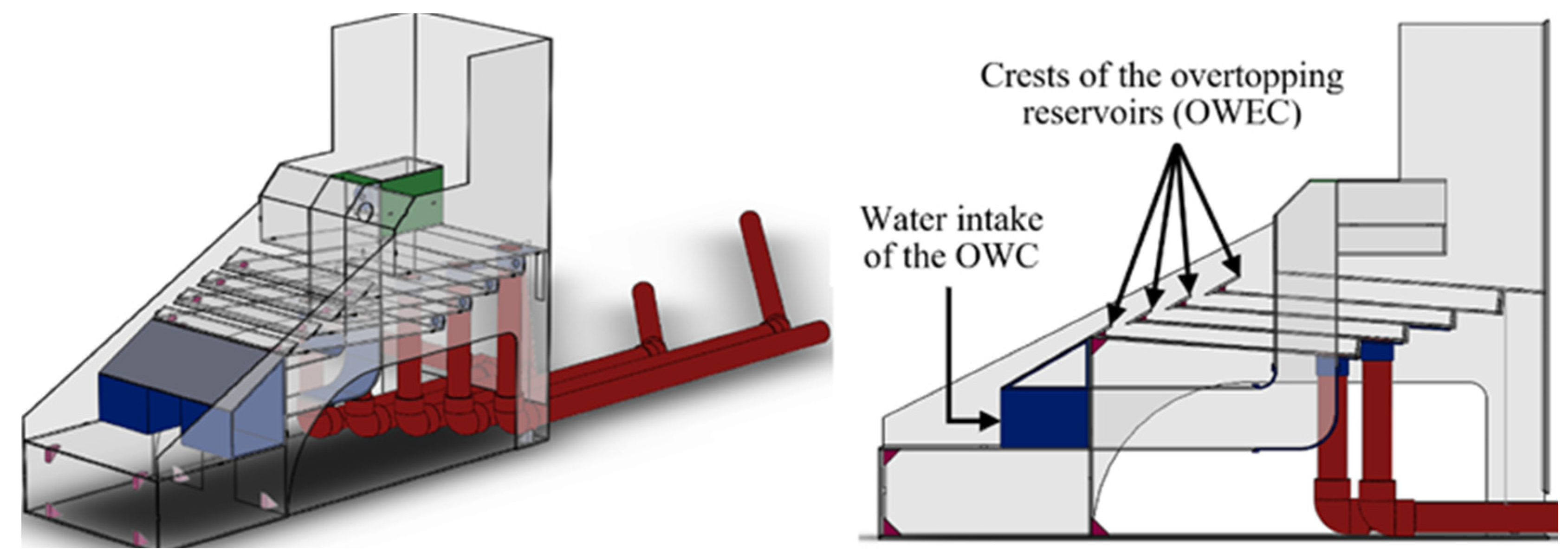
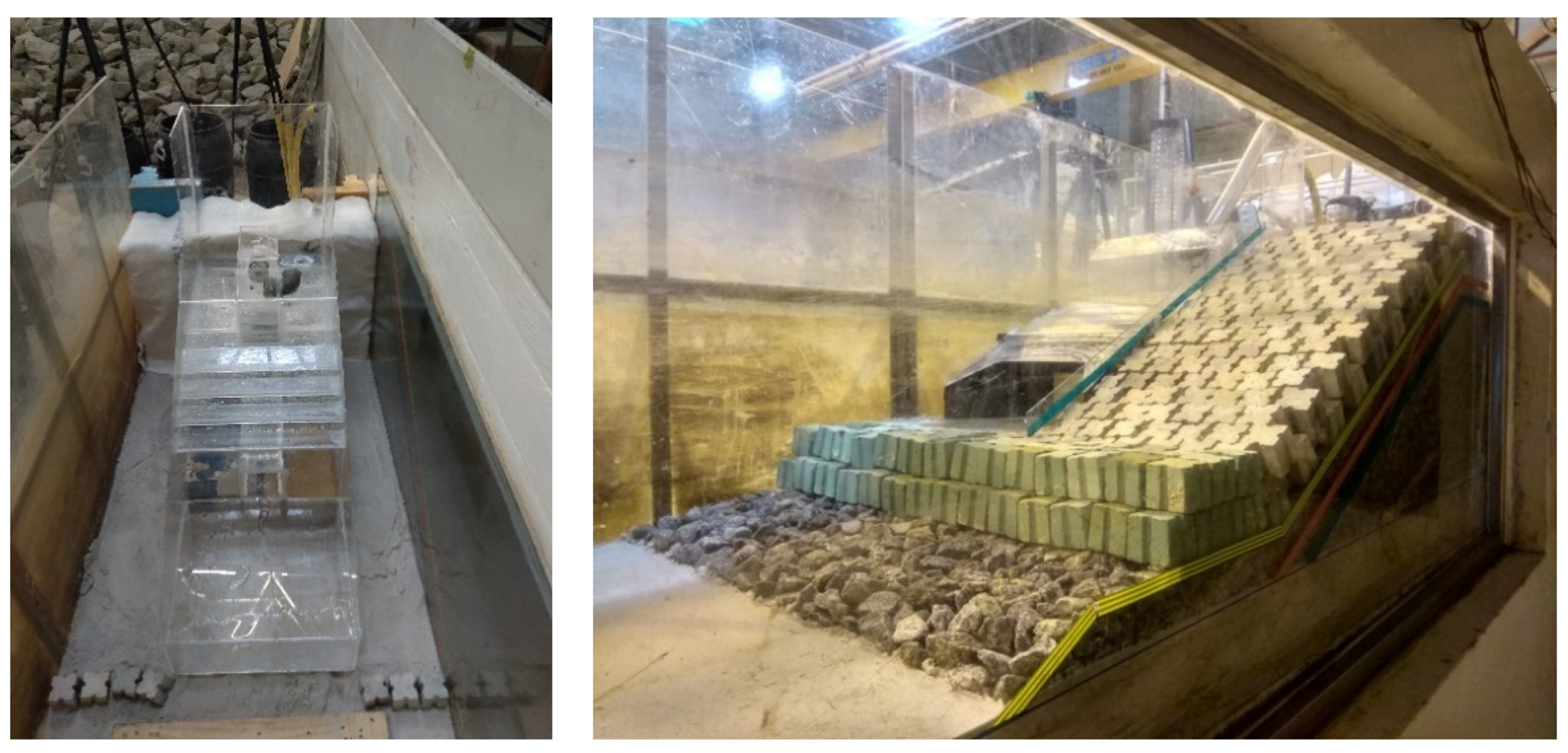
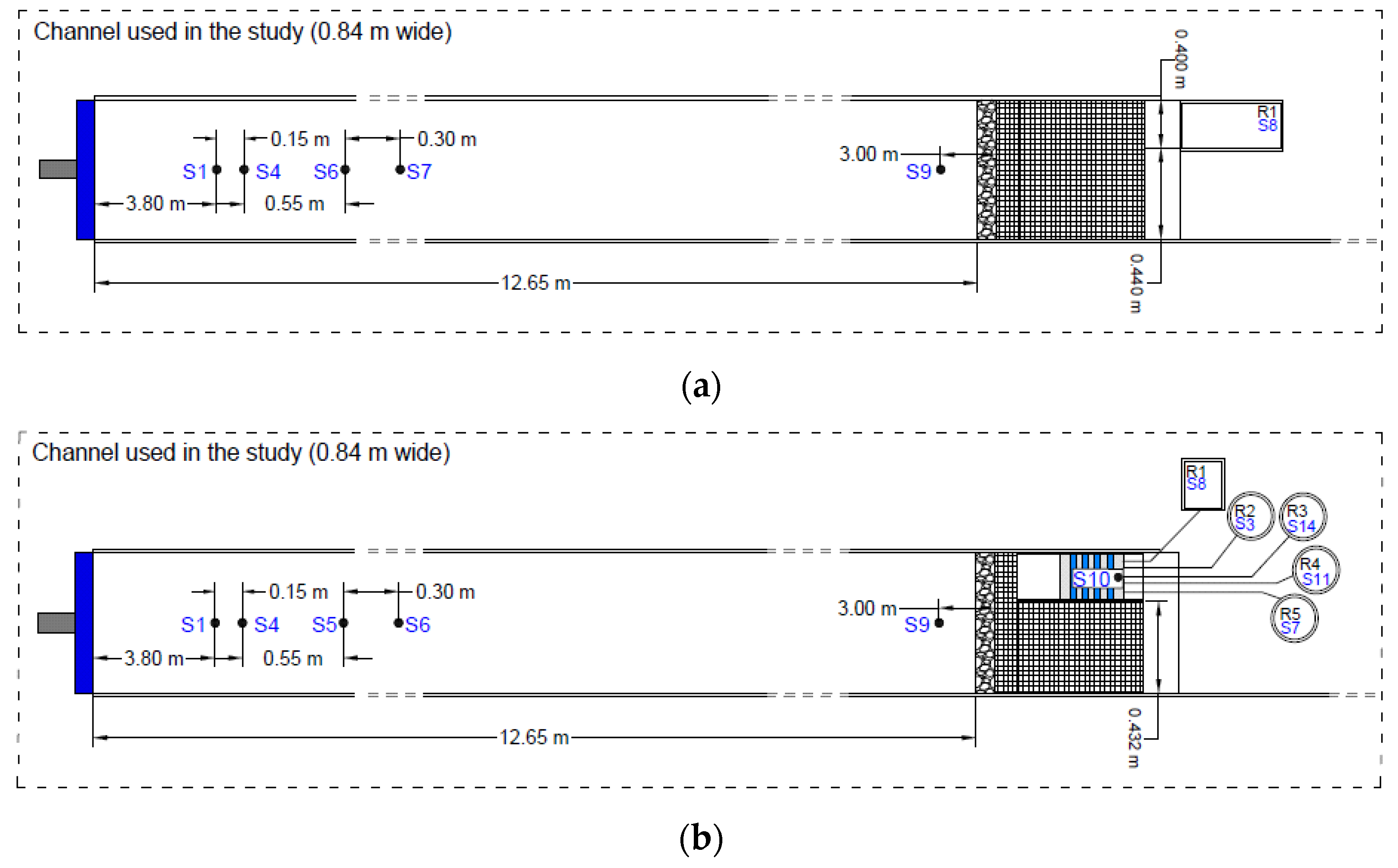
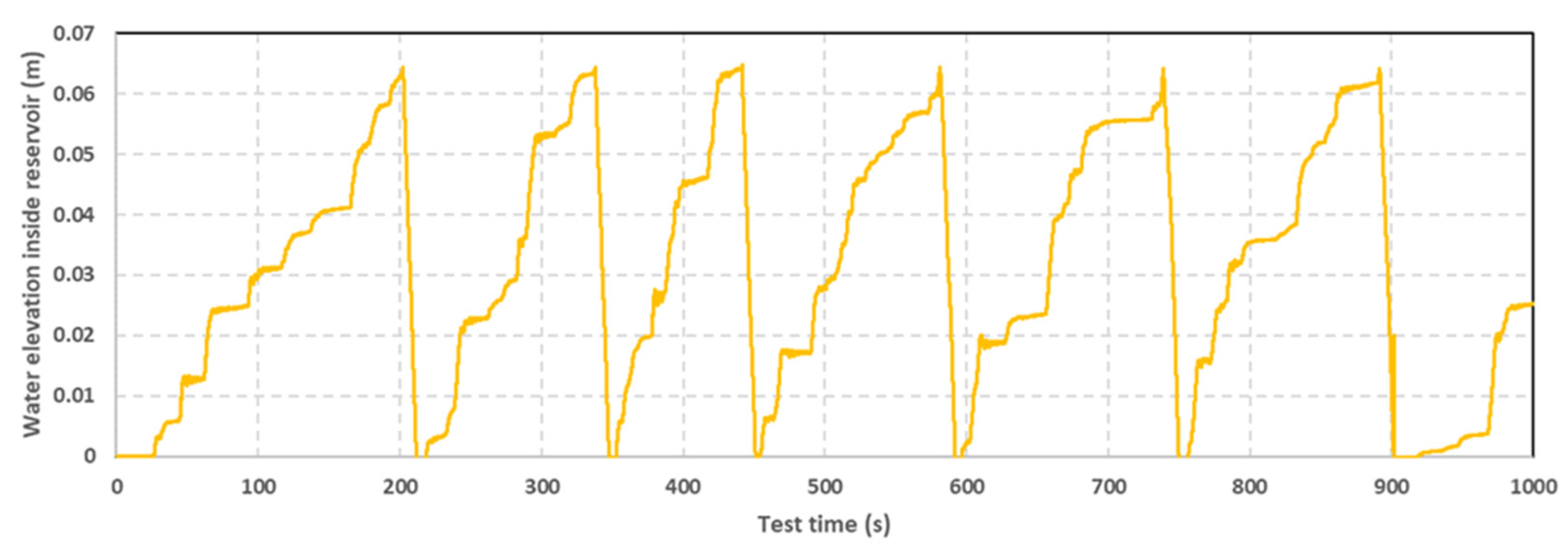
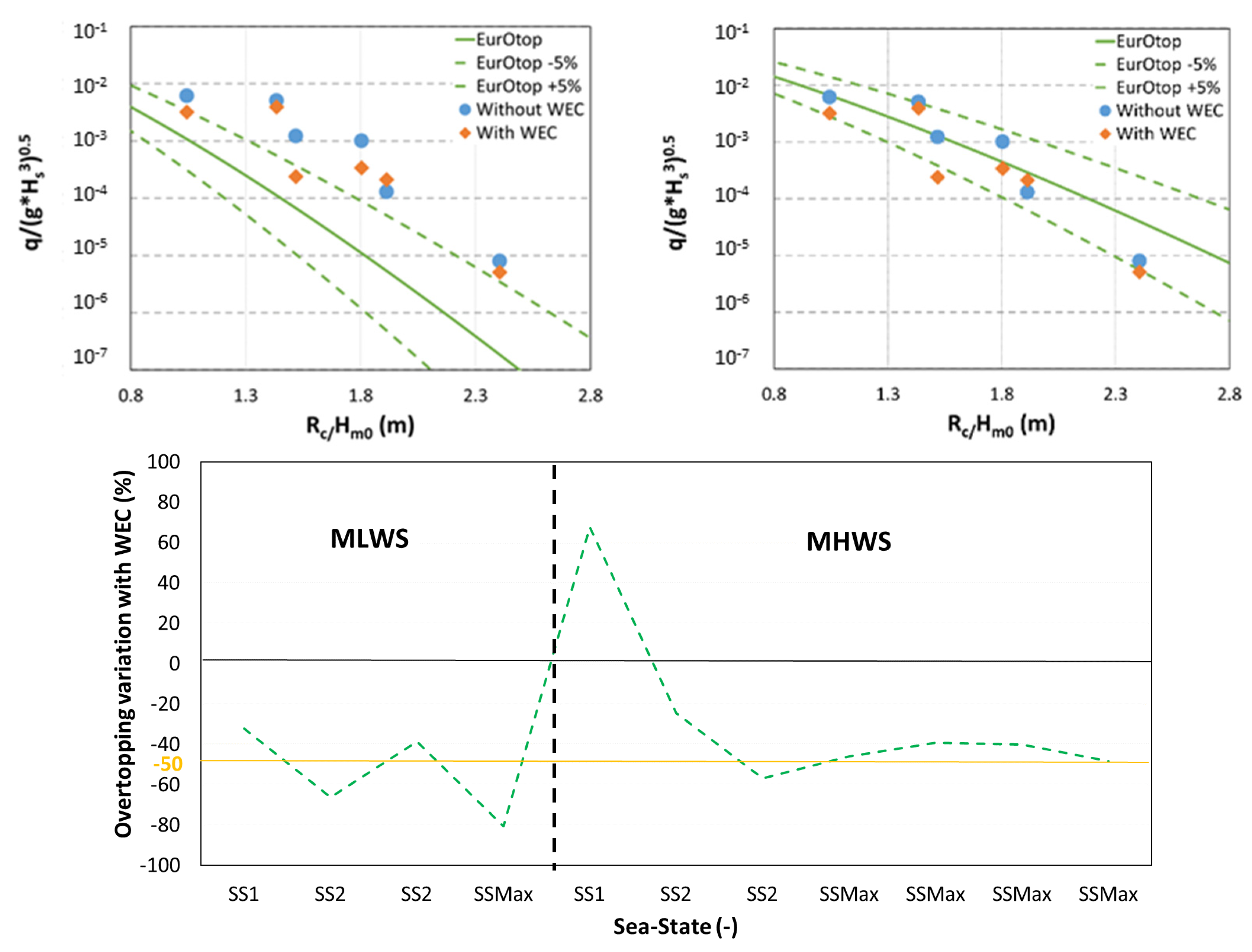
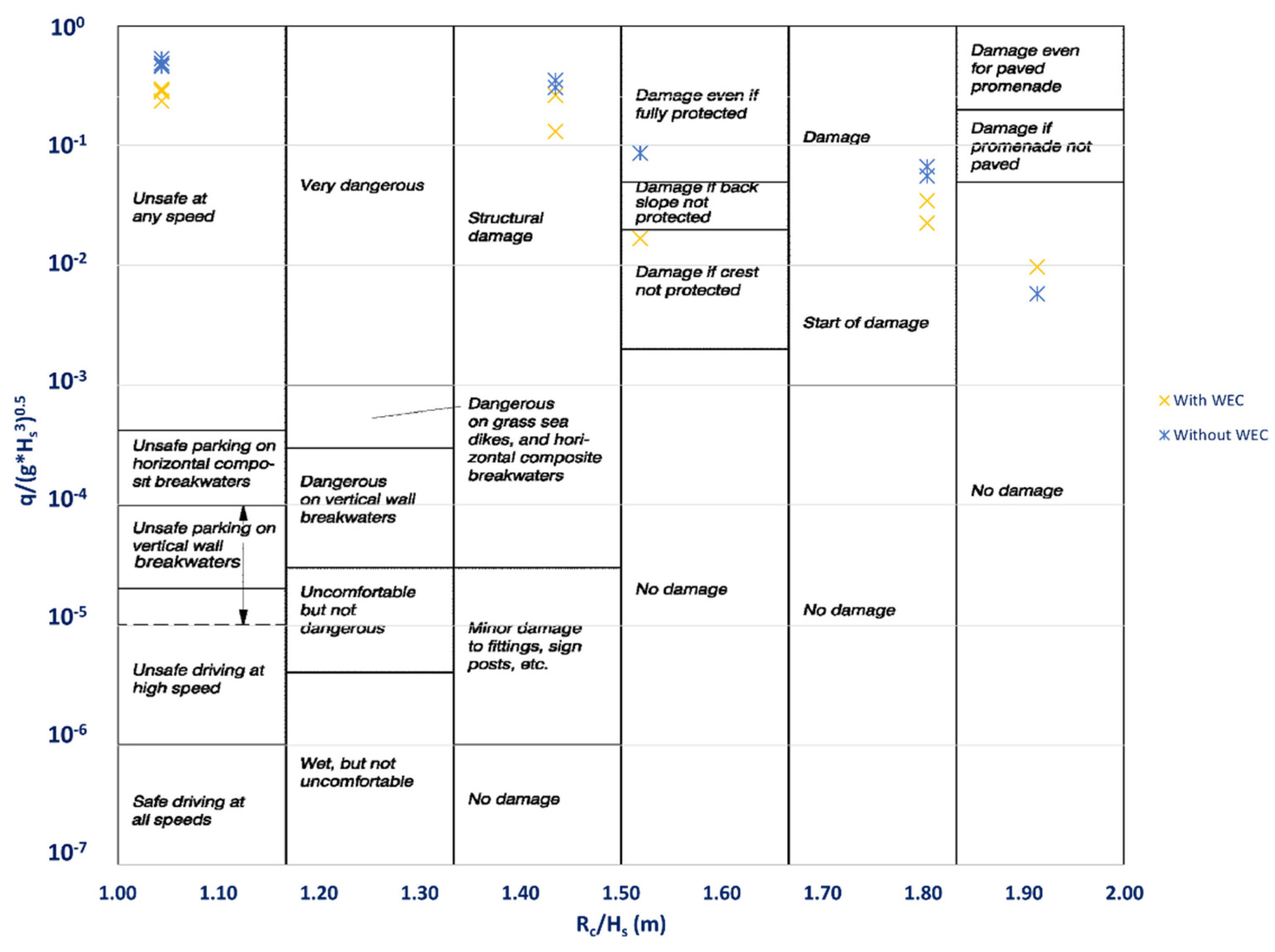
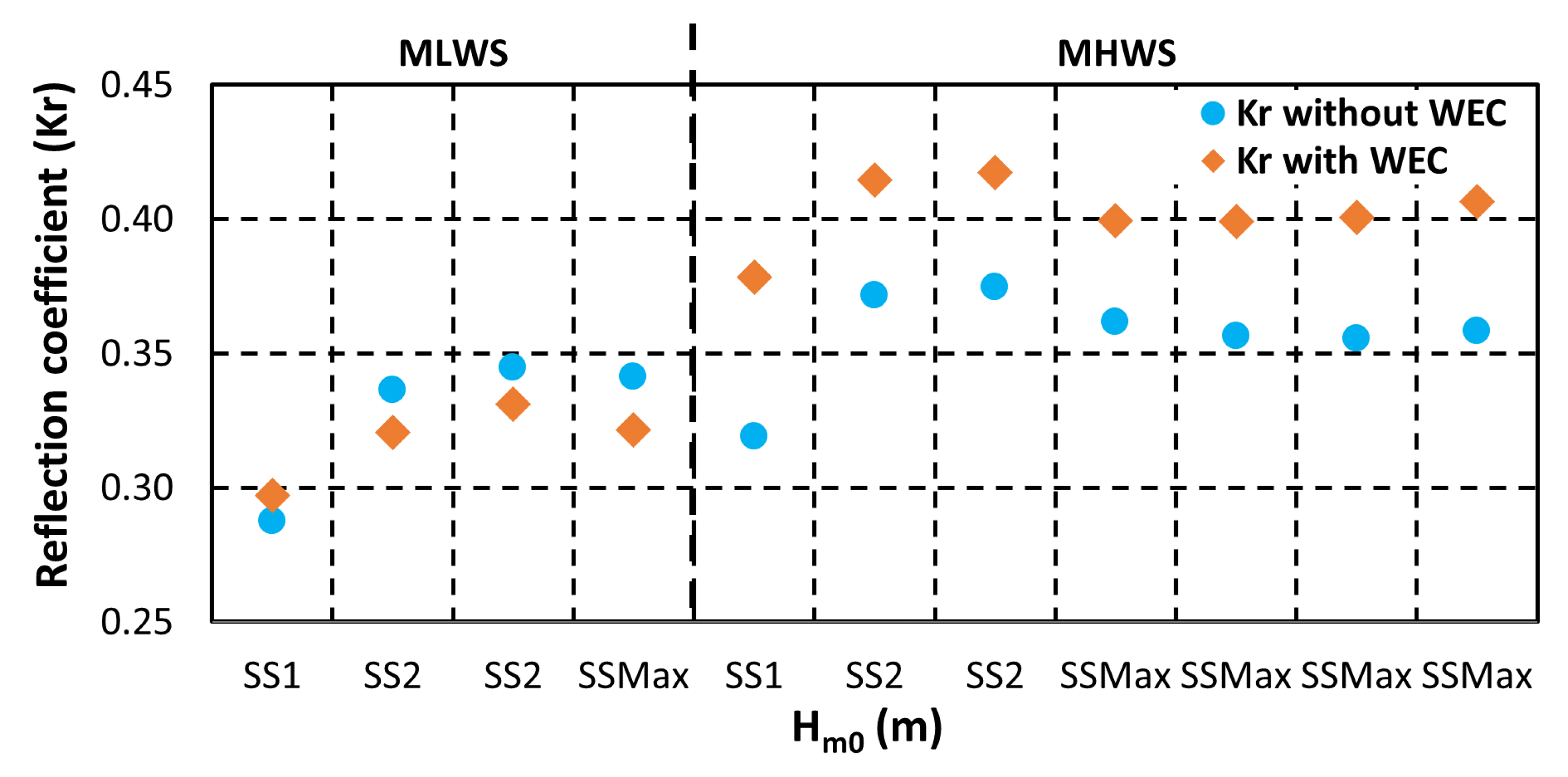

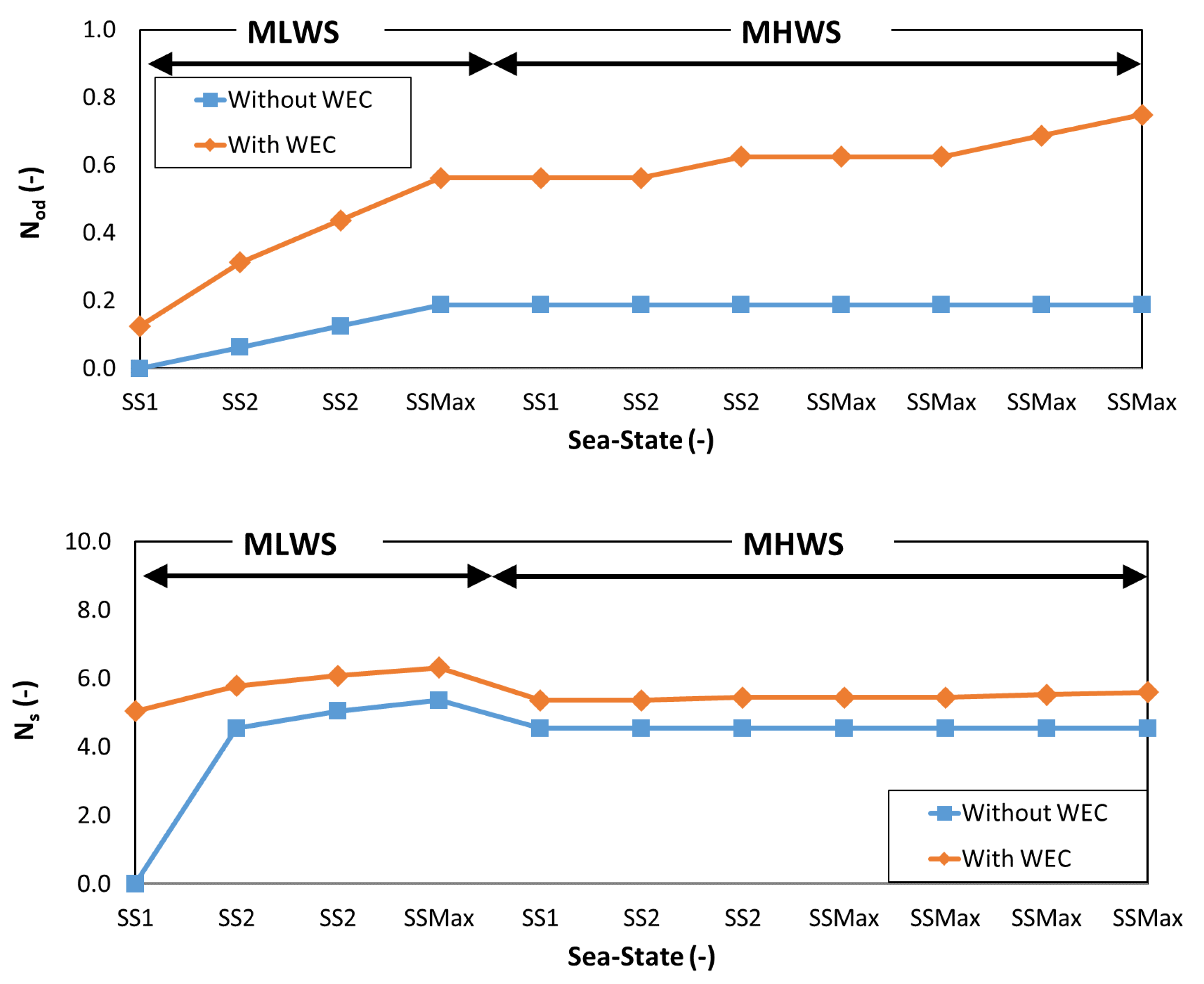

| Sea State | HS (m) | TP (s) | Water Level |
|---|---|---|---|
| SS1 | 6.0 | 13 | MLWS (+0.31 m L.C.D) |
| SS2 | 7.7 | 16 | |
| SSMax | 8.0 | 16 | |
| SS1 | 6.0 | 13 | MHWS (+3.25 m L.C.D) |
| SS2 | 7.7 | 16 | |
| SSMax | 9.1 | 16 |
Publisher’s Note: MDPI stays neutral with regard to jurisdictional claims in published maps and institutional affiliations. |
© 2021 by the authors. Licensee MDPI, Basel, Switzerland. This article is an open access article distributed under the terms and conditions of the Creative Commons Attribution (CC BY) license (https://creativecommons.org/licenses/by/4.0/).
Share and Cite
Clemente, D.; Calheiros-Cabral, T.; Rosa-Santos, P.; Taveira-Pinto, F. Hydraulic and Structural Assessment of a Rubble-Mound Breakwater with a Hybrid Wave Energy Converter. J. Mar. Sci. Eng. 2021, 9, 922. https://doi.org/10.3390/jmse9090922
Clemente D, Calheiros-Cabral T, Rosa-Santos P, Taveira-Pinto F. Hydraulic and Structural Assessment of a Rubble-Mound Breakwater with a Hybrid Wave Energy Converter. Journal of Marine Science and Engineering. 2021; 9(9):922. https://doi.org/10.3390/jmse9090922
Chicago/Turabian StyleClemente, Daniel, Tomás Calheiros-Cabral, Paulo Rosa-Santos, and Francisco Taveira-Pinto. 2021. "Hydraulic and Structural Assessment of a Rubble-Mound Breakwater with a Hybrid Wave Energy Converter" Journal of Marine Science and Engineering 9, no. 9: 922. https://doi.org/10.3390/jmse9090922
APA StyleClemente, D., Calheiros-Cabral, T., Rosa-Santos, P., & Taveira-Pinto, F. (2021). Hydraulic and Structural Assessment of a Rubble-Mound Breakwater with a Hybrid Wave Energy Converter. Journal of Marine Science and Engineering, 9(9), 922. https://doi.org/10.3390/jmse9090922









